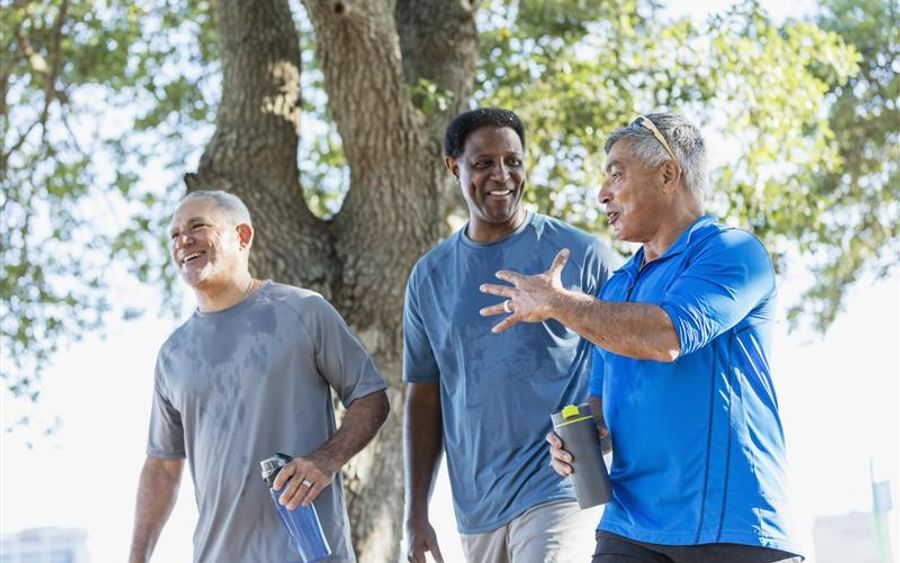What is the link between physical activity and cancer?
When we are active, our body produces chemical reactions that are protective against cancer, particularly if it is for longer periods of time and at higher intensities.
In Australia, physical inactivity is the ninth leading preventable cause of death and disease in our community and research shows that 4.8 per cent of all cancers are linked to being physically inactive.
Regular movement can lower the risk of seven types of cancer including breast, bowel, endometrial, kidney, oesophageal adenocarcinoma and gastric cancer – and may help prevent several others.
How does physical activity help reduce cancer risk?
Physical activity protects your body in many ways:
- Regulates hormones such as oestrogen and insulin which can influence cancer growth.
- Improves digestion which can reduce the time harmful substances stay in contact with the bowel lining.
- Reduces inflammation and supports a healthy immune system, helping the body’s ability to monitor and combat tumours.
How much physical activity should I do?
It’s recommended that all adults do some type of physical activity on most days of the week, preferably every day. Each week, aim for either:
- 2.5 to 5 hours of moderate intensity physical activity such as a brisk walk, golf, mowing the lawn or swimming
- 1.25 to 2.5 hours of vigorous intensity physical activity such as jogging, aerobics, fast cycling, soccer or netball
- an equivalent combination of moderate and vigorous physical activity.
Learn more about physical activity recommendations here.
How much physical activity you should do may be different for children, pregnant women, older Australians, and people with disability and chronic conditions. Find the guidelines that apply to you:
- For infants, toddler and preschoolers (birth to 5 years)
- For children and young people (5-17 years)
- For adults (18-64 years)
- For pregnancy
- For older Australians (65 years and over)
- For people with disability and chronic conditions
Tips to get started with physical activity
New research shows that for people who aren’t regularly active, short bursts of movement – even just 1-2 minutes at a time – can make a difference to health and lowering cancer risk.
This can include:
- Carrying shopping bags
- Walking briskly to catch the bus
- Taking the stairs instead of the lift
- Dancing
- Playing a short active game with children or grandchildren.
Doing any physical activity is better than doing none. If you do no physical activity right now, start by doing some and then slowly build up to the recommended amount. Some people might need to speak to their doctor before starting new physical activities.
Tips for being more active
- Think about the short-term benefits like improved mood, boost of energy and better sleep.
- Incorporate extra movement in your everyday life, such as walking instead of driving, or walking part way to your destination.
- Get off the train or bus one stop earlier and walk the rest of the way.
- Combine movement with housework or gardening by tackling more physical chores like mowing the lawn or vacuuming.
- Keep it social by joining a walking group (such as Heart Foundation Walking) or finding your local parkrun.
- If you’re short on time, break your activity bursts into shorter sessions throughout the day.
Aim for a mix of activities
- Get huffing and puffing through activities like swimming, netball, dancing, jogging or riding a bike.
- Work on muscle strengthening activities including squats, push ups against a wall or carrying your groceries.
- Work on your mobility, balance and coordination including standing on one leg when brushing your teeth, or gentle stretching when you get out of bed.
- For those who track daily steps, aim for 6,000 to 8,000 or more steps per day.
- Break up sitting and sedentary time as often as possible.
References
Ellis L, Milne RL, Moore MM, Bigby KJ, Sinclair C, Brenner DR, Moore SC, Matthews CE, Bassett JK, Lynch BM. Estimating cancers attributable to physical inactivity in Australia. J Sci Med Sport. 2024 Mar;27(3):149-153. doi: 10.1016/j.jsams.2023.12.002. Epub 2023 Dec 7. PMID: 38103985; PMCID: PMC10939860.
Australian Institute of Health and Welfare. Physical activity [Internet]. Canberra: Australian Institute of Health and Welfare, 2023 [cited 2024 Apr. 3]. Available from: https://www.aihw.gov.au/reports/physical-activity/physical-activity
Stamatakis E, Ahmadi MN, Friedenreich CM, et al. Vigorous Intermittent Lifestyle Physical Activity and Cancer Incidence Among Nonexercising Adults: The UK Biobank Accelerometry Study. JAMA Oncol. 2023;9(9):1255-1259. doi:10.1001/jamaoncol.2023.1830
